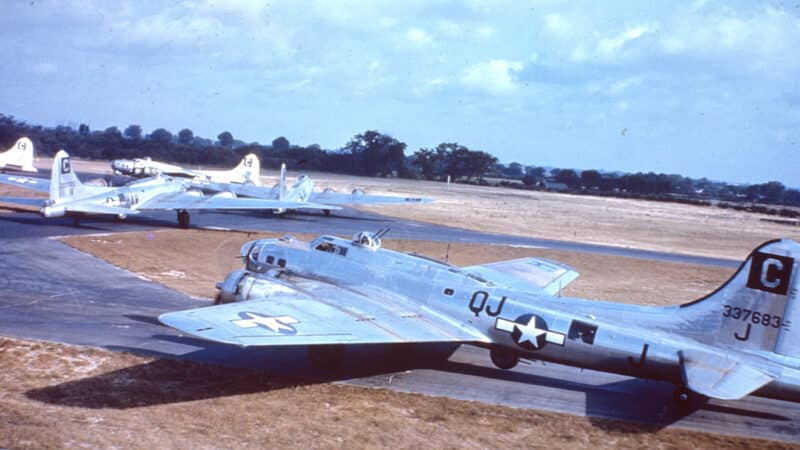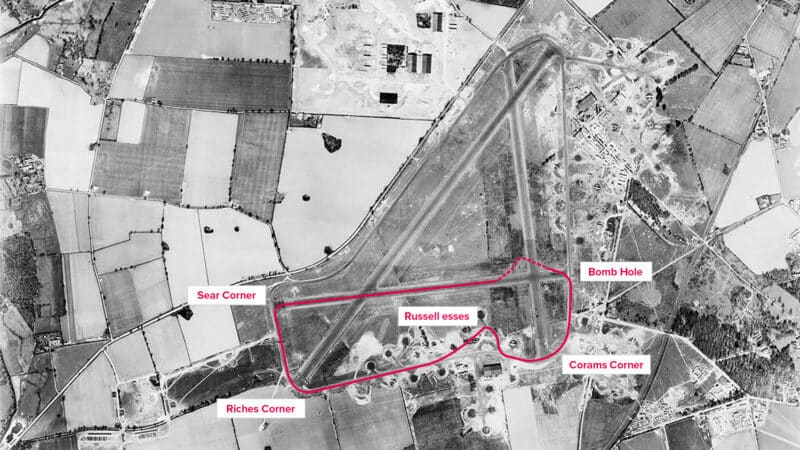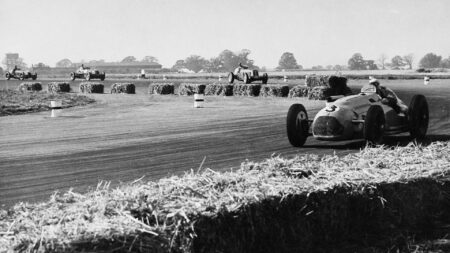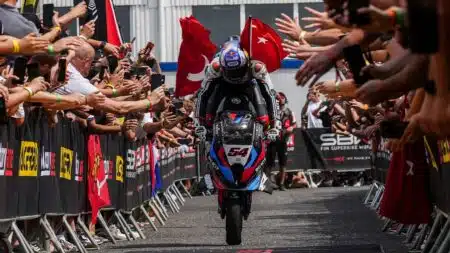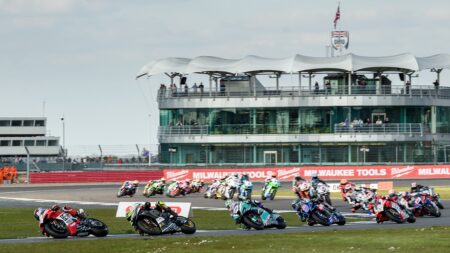Snetterton Heath RAF base opened in early 1943 and became home to the American 96th Bombardment Group as the Allies amassed forces in preparation for the invasion of Europe. The 96th flew B-17 Flying Fortresses and played an important part in many major actions, including D-Day.
Like most bomber groups, the 96th sustained horrific casualties – in the year leading up to D-Day it lost a hundred B17s, a thousand men, either killed, injured, captured or on the run in Europe.
Its most famous mission came in August 1943 when the target was a factory that manufactured Messerschmitt fighters in Regensburg, deepest southeast Germany. The 96th was teamed with six other bomb groups, all East Anglia-based, including the 100th, based at Thorpe Abbotts, 15 miles south-east of Snetterton.
The mission plan had a twist. Air force leaders knew the armada of 146 B-17s would come under heavy attack from Luftwaffe fighters and flak during the flight to and from Regensburg, so instead of returning home it dodged the homeward fireworks by heading southwest, all the way to Algeria, North Africa. Then back to Thorpe Abbotts after a few days of rest and repairs.
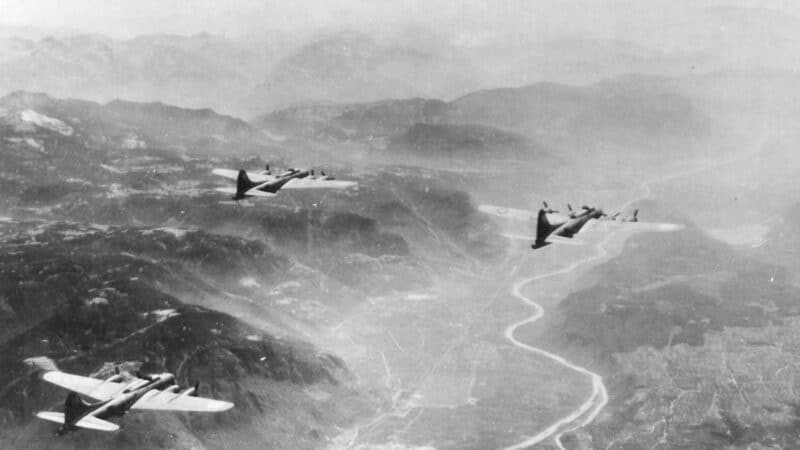
B-17s flying over the Alps after the Regensburg raid, on their way to North Africa, so they didn’t have a two-way trip through German flak and fighter attacks
National Museum of the United States Air Force
The mission was a great success but came with heavy losses. A total of 24 B-17s were lost, with 240 crew. This time the 96th didn’t lose a single plane, while the 100th lost nine of its 21 B17s. On another mission in 1943, 60 USAAF B-17s were shot down – 600 crew.
The losses were so great that it was never easy to keep enough aircrew and planes in the air. The Americans bombed by day while the British bombed by night. RAF losses were even worse – 57,205 fatalities from a total of 125,000 crew, a 46% death rate – because their planes were usually shot down by heavy flak, not machine-gun fire from fighters.
The story of the so-called Bloody 100th is told in the recently released Apple TV series Masters of the Air.
The B-17 was a mighty machine, powered by four supercharged 1200-horsepower nine-cylinder radial engines, armed with 13 machine guns and carrying a bomb load of up to 7.8 tonnes. Almost 13,000 were built.
In 1952 Snetterton Heath was returned to its original owner, farmer Fred Riches (after whom the first corner was named), who sold it to Oliver Sear and Dudley Coram of the Aston Martin Owners Club, whose surnames were also used to christen corners. Snetterton hosted its first car races in 1951 (reported in Motor Sport Magazine!) and its first motorcycle races two years later.
The original circuit layout consisted largely of taxiways and runways. The start/finish, Riches, Sears, Coram Curve and Russells esses were all taxiways, while the back straight was the airbase’s east/west runway.
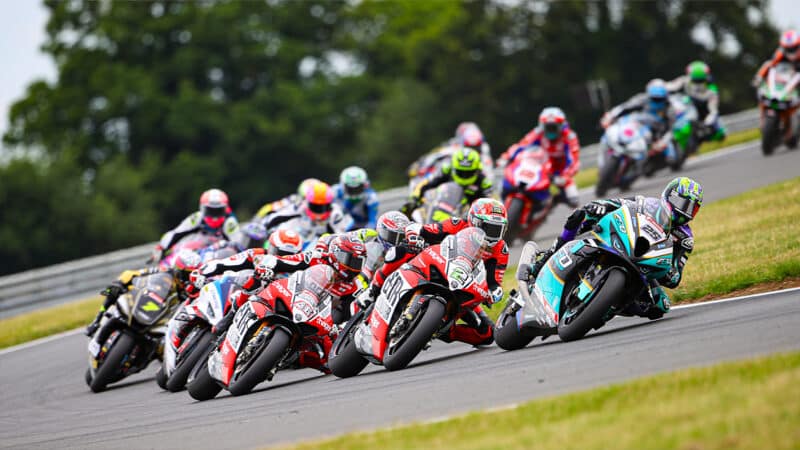
Snetterton now – a 2023 BSB race at the track, which hosted its first motorcycle race in 1953
Traces of Snetterton’s origins abound around the circuit site, including sections of concrete runway, runway light fittings, hardstands, Nissen huts, crew rooms and air-raid shelters.
The first Second World War base to officially host motorcycle races was Northern Ireland’s Long Kesh, from where Spitfires and Tomahawks had flown. Its first meeting took place in November 1945, with ticket proceeds going to RAF charities.
The seventy-plus Second World War bases (a few date back to the First World War) that have hosted motorcycle racing across England, Northern Ireland, Scotland and Wales were often used for racing thanks to the efforts of the Royal Air Force Motor Sports Association:
Aghadowey (Derry), Aldegrove (Antrim), Andreas (Isle of Man), Ansty (Warwickshire), Balado Bridge (Kinross-shire), Ballykelly (Derry), Barskstone Heath (Lincs), Biggin Hill (Kent), Bishopscourt (Down), Brough (Yorks), Boreham (Essex), Carnaby (Yorks), Castle Combe (Wilts), Catterick (Yorks), Charterhall (Scottish Borders), Chivenor (Devon), Colerne (Wilts), Crail (Fife), Crimond (Aberdeenshire), Croft (Yorks), Darley Moor (Derbyshire), East Fortune (East Lothian), Edzell (Angus), Elvington (Yorks), Errol (Perth and Kinross), Fairwood (Gower Peninsula), Flookburgh (Cumbria), Gamston (Nottinghamshire), Gask (Perthshire), Grandsden Lodge (Cambridgeshire), Gaydon (Warwickshire), Goodwood/Westhampnett (West Sussex), Haddenham, (Buckinghamshire), Jurby (Isle of Man), Keevil (Wilts), Kinnell (Angus), Kirkistown (Down), Little Rissington (Gloucestershire), Llandow (Vale of Glamorgan), Long Kesh (Lisburn), Long Marston (Warwickshire), Maghaberry (Antrim), Middleton St George (Country Durham), Mona (Anglesey), Moreton Valence (Gloucestershire), Newtownards (Down), North Weald (Essex), Nutts Corner (Antrim), Ouston (Northumberland), Pembrey (Carmarthenshire), Perton (Staffordshire), Radlett (Herts), St Angelo (Fermanagh), St Athan (Glamorgan), St Eval (Cornwall), Sculthorpe (Norfolk), Silloth (Cumbria), Silverstone (Northants), Snetterton (Norfolk), Stapleford Tawney (Essex), Staverton (Gloucestershire), Thornaby (Yorks), Thorney Island (West Sussex), Thruxton (Hampshire), Tilstock (Shropshire), Tofanau (Gwynedd), Tranwell (Tyne and Wear), Waterbeach (Cambridgeshire), Wellesbourne (Warwickshire), West Raynham (Norfolk), Winfield (Scottish Borders), Wroughton (Wilts).
